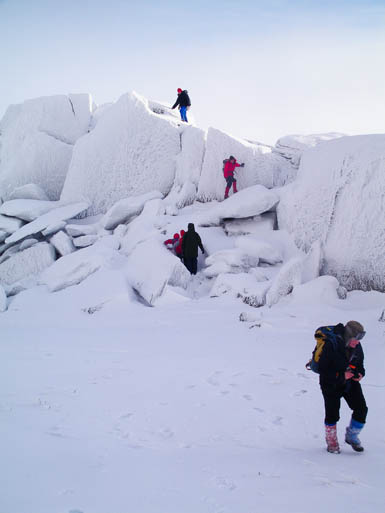Walkers and mountaineers are being warned to take care in Snowdonia after reports of two separate avalanches.
Members of the Ogwen Valley Mountain Rescue Organisation yesterday spent three hours searching the area around Aber Falls, after a headtorch was found in a stream where a large amount of avalanche debris had accumulated. It is estimated about 500 tons of snow slid down the hillside.
Thirty team members, with the help of three Search and Rescue Dogs Association handlers and their animals, probed the snow to a depth of 3m, but found no sign of anyone.
Chris Lloyd of the team urged caution however. He said the area, north of Yr Elen, was popular with walkers, being accessible from the main North Wales A55 dual carriageway. Snow in the area is slowly thawing, with further rises in temperatures due over the weekend.
Mr Lloyd described the incident: “Two walkers went up to Aber Falls after dark to view the partially frozen falls. At the base of the falls they noticed an illuminated head torch in the river. There were no footprints in the snow covered rocks in and around the river.
“However, to the left of the falls there was a cone of avalanche debris about 30m wide at its foot and rising 20m up the slope.
“Thinking that someone might have been buried whilst viewing the falls in winter, they departed the scene rapidly to an area where they could get a mobile phone signal and telephoned 999 at about 8.30pm.
“About 30 members of Ogwen Valley Mountain Rescue Organisation were eventually deployed on the search and three members of SARDA with their dogs.
“Initially the cone was swept by one dog. Then the team members started a fine probe up the cone. The snow was over 2m deep at the base of the cone.
“Team members then probed a smaller cone further to the left. Once the probing was complete, four team members went to check the area from where the snow had fallen. No evidence was found so all troops retired at about 11pm.
“The North Wales Police helicopter made an overflight today but nothing found. There is no car left and no one reported overdue, so we will wait for the thaw.”
Another avalanche report was reported on the Nant Peris side of Y Garn, where a full-depth slide has occurred from a crown wall that was more than a metre high. The debris carried a long way down the mountainside according to Jon Garside of the British Mountaineering Council.
Ice climbs that were previously in condition are now becoming unstable as temperatures slowly move above freezing.
Avalanche risk is also widespread in the Lake District where cornices are becoming unstable and windslab has built up in many places.
The national park’s felltop assessor said: “Both Striding and Swirral Edges are in full winter condition, however the exits cross windslab – loosely bonded snow – covered with a fresh layer of snow, so great care needs to be taken.
“Similarly, gullies are full of windslab and are very unstable. Indeed, there have been reports of avalanches taking place at various Lake District locations. The snowpack has yet to undergo any significant thaw-freeze cycle so steep routes remain extremely hazardous.
“Today there were patches of wet snow, making steep routes more dangerous until it re-freezes. Cornices have formed along the summit ridges, so please keep well back from the edge and advise others to do likewise.”
In the Highlands, all five areas covered by the sportscotland Avalanche Information Service have a high risk of avalanche – meaning both natural and human-induced snow slides will occur – on certain slope aspects as low as 600m.
The Mountain Weather Information Service forecasts rain replacing snow on all but the highest mountains as the general thaw takes hold in the next few days over Britain.

![[CC-2.0]](/lib/img/layout/cc-attr.gif)